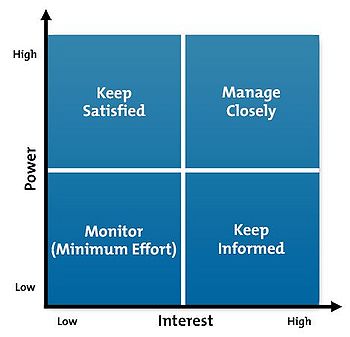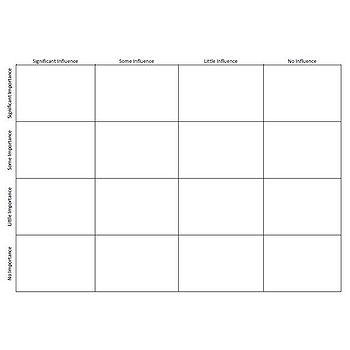Stakeholder Analysis and Matrices
Stakeholders are referred to as actors (persons or organizations) with a vested interest in the decision or policy that is being promoted. Stakeholder analysis is the method or process used to identify these actors or key individuals/groups that will have an affect on a project, and how to win them over. Stakeholder analysis allows policy and/or decision makers to interact more effectively with key stakeholders; detect and act to prevent potential misunderstandings about and/or opposition to the policy or program; and increase support for a given policy or program.
Contents |
Background
Process
Stakeholder Analysis

The stakeholder analysis can be useful in the way that policymakers and managers can identify key players and assess their knowledge, interest, position, alliance, and importance to the project or policy. By using the analysis, managers can interact more effectively with key stakeholders and increase their support. The stakeholder analysis is conducted before a program is implemented. This allows managers or policymakers to prevent potential misunderstandings about and/or oppositions to the program or policy. [3]
The analysis characterizes stakeholders and provides the information that is needed for a manager to know where his focus should be during the program or policy. The analysis includes the stakeholders’ interests in the project, positions for or against it, potential alliances with other stakeholders, and also their ability to affect the process.
Stakeholder Matrix

How to make a Stakeholder Analysis Matrix
1. Make a list of all stakeholders
2. Write the name of each stakeholder on a post-it note or index card
3. Rank the stakeholders on a scale of one to five, according to one of the criteria on the matrix, such as ‘interest in the project outcomes’ or ‘interest in the subject’
4. Keeping this ranking for one of the criteria, plot the stakeholders against the other criteria of the matrix. This is where using post-it notes or removable cards are useful
5. Ask the following questions:
- Are there any surprises?
- Which stakeholders do we have the most/least contact with?
- Which stakeholders might we have to make special efforts to ensure engagement? [5]
After asking these questions, put the post-its or removable cards in the matrix where you think they best fit.
Benefits
Challenges and Uncertainty
Conclusion
References
- ↑ Cite error: Invalid
<ref>tag; no text was provided for refs namedPI - ↑ https://www.mindtools.com/pages/article/newPPM_07.htm
- ↑ http://www.eestum.eu/voorbeelden/Stakeholders_analysis_guidelines.pdf
- ↑ http://www.brighthubpm.com/templates-forms/3713-performing-a-stakeholder-analysis/?PageSpeed=noscript
- ↑ http://www.dse.vic.gov.au/effective-engagement/toolkit/tool-stakeholder-analysis-stakeholder-matrix
Further Readings
Cite error:
<ref> tags exist, but no <references/> tag was found